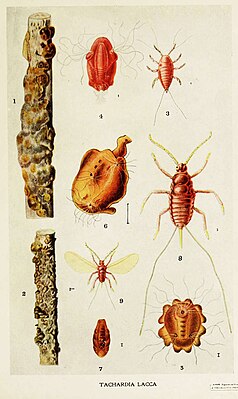Paint scale louse
| Paint scale louse | ||||||||||||
|---|---|---|---|---|---|---|---|---|---|---|---|---|

Illustrations of the lacquer scale insect from Indian Insect Life by Harold Maxwell-Lefroy |
||||||||||||
| Systematics | ||||||||||||
|
||||||||||||
| Scientific name | ||||||||||||
| Kerria Lacca | ||||||||||||
| ( Kerr , 1782) |
The lac insect ( Kerria lacca ) is a scale insect - kind from the family of Kerriidae . Shellac and dye varnish are obtained from the resinous excretions of the lacquer scale insect .
features
The males and females of the lacquer scale insect are characterized by an extreme sexual dimorphism . The females are about one to two millimeters tall and wingless.
The larvae are about 0.6 millimeters long and 0.25 millimeters wide. One or two days after the nymphs have settled on the host plant, the excretion of waxy secretions begins.
distribution
The lacquer scale insect is common in the Neotropics ( Guyana ), in the Orient ( Bangladesh , Burma , China , India , Malaysia , Nepal , Pakistan , Sri Lanka , Taiwan ) and in the Palearctic region ( Azerbaijan , Georgia ).
Way of life
The lacquer scale insect feeds on the sap of numerous tree species. It has so far been detected on 71 plant species from 23 plant families. These include representatives from the following families: Sumac (Anacardiaceae), annonaceous (Annonaceae), Hundsgiftgewächse (Apocynaceae), Birch Family (Betulaceae), Cucurbitaceae (Cucurbitaceae), dipterocarpaceae (Dipterocarpaceae), ebenaceae (Ebenaceae) erythroxylaceae (Erythroxylaceae), spurge family (Euphorbiaceae ), walnut family (Juglandaceae), legumes (Fabaceae), mallow (Malvaceae), meliaceae (Meliaceae), mulberry family (Moraceae) proteaceae (Proteaceae) Punicaceae , buckthorn family (Rhamnaceae), Rosaceae (Rosaceae), Rutaceae (Rutaceae), pasture plants (Salicaceae), soap tree family (Sapindaceae), linden family (Tiliaceae), grapevine family (Vitaceae).
The females live in colonies. Only fertilized females prick the bark of young branches and ingest significant amounts of phloem sap . The resin taken up by the host plant is excreted in a secretion and forms a solid crust on the surfaces of the branches. The excreted substance consists of 79% resin acids, 2% esters of wax alcohols, 7% chemically neutral substances (including dyes) and 12% polybasic esters. The excretions are called stick varnish or rubber varnish . They are collected and processed into shellac (E 904). 300,000 animals produce 1 kg of shellac.
Economical meaning
The resinous excretions of the lacquer scale insect were and are mainly used commercially in India, Thailand, Indonesia, Burma (Myanmar) and China. In Europe in the Middle Ages and the early modern period, dye made from lacquer scale lice could not prevail, although there was a lack of red dye at that time. European dyers found it difficult to handle the resinous waste products. They mainly used it to dye leather red.
Important host plants include the Malabar lacquer tree ( Butea monosperma ) grown in India , the Indian jujube ( Ziziphus mauritiana ) and Schleichera oleosa . In India, around three million people are employed in the extraction of rubber lacquer, with around 18,000 tons being produced each year. About 80% of the country's production is exported, which corresponds to a trade volume of 16 to 22 million US dollars.
Systematics
Subspecies
So far, four subspecies of the lacquer scale insect have been described:
- Kerria (Kerria) lacca ambigua (Misra)
- Kerria (Kerria) lacca lacca (Kerr)
- Kerria (Kerria) lacca mysorensis (Mahdihassan)
- Kerria (Kerria lacca takahashii Varshney)
to form
Varshney described two forms of lacquer scale insect in 1976. Kerria lacca lacca f. rangeeni colonizes Ficus species and the Malabar lacquer tree, but is not found on Schleichera oleosa . The summer generation of this form lives eight months from October / November to June / July and is known as the Baishaki generation. The rainy season generation lives for about four months - from June / July to October / November and is known as the Katki generation. This form is the more common form in India, although the quality of the rubber varnish made from it is inferior.
The second form Kerria lacca lacca f. kusumi colonizes Schleichera oleosa and some other plant species, but is not found on the Malabar lacquer tree. The life cycle of each generation is about six months. The summer generation lives from January / February to June / July and is known as the Jethwi generation. The winter generation lives from June / July to January / February and is known as the Aghani generation. The kusumi form is rarer, but provides a better quality rubber varnish.
Synonyms
In the literature, the following synonyms are used for the scientific name of the lacquer scale insect:
- Coccus gummilaccae Goeze, 1778
- Coccus lacca Kerr, 1782
- Coccus ficus Fabricius, 1787
- Chermes lacca Roxburgh, 1791
- Carteria lacca Signoret, 1874
- Kerria lacca Targioni Tozzetti, 1884
- Tachardia lacca
- Tachardia (Tachardia) lacca Chamberlin, 1923
- Lakshadia indica Mahdihassan, 1923
- Laccifer lacca Cockerell, 1924
- Kerria (Kerria) lacca lacca Varshney, 1984
swell
- ScaleNet.info: Kerria lacca .
- CL Metcalf, WP Flint: Destructive and Useful Insects - Their Habits and Control. 3rd edition, Mc Graw-Hill Book Company, 1951.
Individual evidence
- ↑ a b c d e f Kerria Targioni Tozzetti. United States Department Of Agriculture, Agriculture Research Service ( Memento from December 14, 2012 in the web archive archive.today ).
- ↑ Hans Strümpel: Homoptera (plant suckers). Series Handbuch der Zoologie, De Gruyter, 1983, ISBN 978-3-11-008856-4 , limited preview in the Google book search.
- ^ Amy Butler Greenfield, A Perfect Red - Empire, Espionage and the Qest for the Color of Desire. HarperCollins Publisher, New York 2004, ISBN 0-06-052275-5 , p. 29.
- ^ Niranjan Prasad, AK Jaiswal, KK Kumar: Energy requirement in lac production. In: Agricultural Mechanization in Asia, Africa and Latin America. Vol. 35, No. 1, 2004, pp. 54-58.
Web links
- Anantanarayanan Raman: Discovery of Kerria lacca, the lac insect, in India in the late 18th century. In: Current Science. Vol. 106, No. 6, May 25, 2014 (PDF, English)